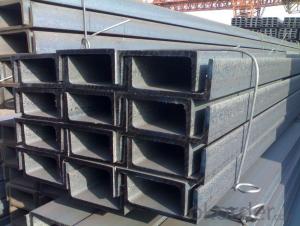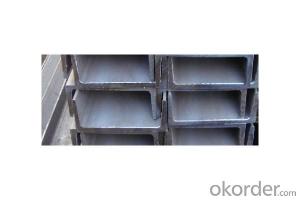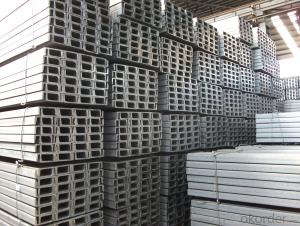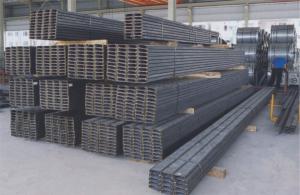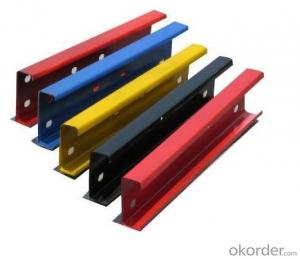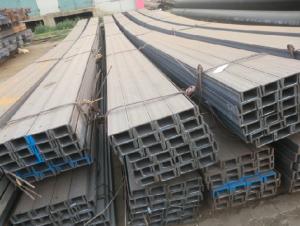Hot-rolled steel channel
- Loading Port:
- China Main Port
- Payment Terms:
- TT OR LC
- Min Order Qty:
- -
- Supply Capability:
- -
OKorder Service Pledge
OKorder Financial Service
You Might Also Like
Channel is the section groove strip steel. Channel steel is used in the construction and machinery for carbon structural steel, steel steel section is complex, its sectional shapegroove. Channel steel is mainly used for building structure, the curtain wall engineering,mechanical equipment and vehicle manufacturing etc.. Request it has better welding, rivetingperformance and comprehensive mechanical properties in use. Steel billet production raw materials are carbon content not exceeding 0.25% of the carbon steel or low alloy steel billet.Product channel steel after hot forming, normalizing or hot-rolled state of delivery. Thespecifications to waist high (H) * leg width (b) * waist thick (d) millimeter number representation, such as 100*48*5.3, said waist height 100 mm, width of 48 mm steel legs,waist thickness was 5.3 mm, or 10# channel. Waist high the same channel, if there are several different wide legs and waist thickness also need to add a B C to be the difference in the types of the right, such as 25#a 25#b 25#c etc..
Classification
Channel can be divided into ordinary steel and light channel. Hot rolled ordinary channelspecifications for 5-40#. By both sides of supply and demand supply of hot rolled flexiblechannel protocol specifications for 6.5-30#. Channel steel is mainly used for building structure, vehicle manufacturing, other industrial structure and a fixed disk cabinet, steeloften used together with choices.
Channel steel according to shape and can be divided into 4 kinds: Leng Wan equilateral channels, Leng Wan scalene channel, Leng Wan edge channel, Leng Wan channel section with outer edge
In accordance with the steel structure theory, should be the channel steel flange force, that is to say the channel should be upright, not lying.
No.
With international chemical symbols for the element and its symbols to represent the chemical composition, in Arabia letter to indicate the contents of components:
Such as: China, Russia 12CrNi3A
Using a fixed number of bits to represent the steel series digital or digital; such as: the United States, Japan, 300 series, 400 series, 200 series;
Using the Latin alphabet and their sequence number, only that the use of.
The specification set
Channel steel specifications mainly used high (H), Tui Kuan (b), waist thickness (d) and othersize
Channel steel (3)
Said that at present domestic steel specifications from 5 to 40, that is, the correspondingheight of 5 to 40cm.
At the same height, light channel than common channel steel legs, waist narrow thin, light weight. 18 - 40, 5 - 16 for large channel, channel steel for medium channel. The importchannel indicate the actual size and related standards. Steel import and export orders generally is in determining the corresponding (carbon steel or low alloy steel) steel after,required the use specifications in the main. In addition to specifications, outside the channelwithout specific composition and performance series.
The delivery channel length is divided into fixed length, double length two, and the provisions of tolerance in the corresponding standard. The domestic channel length selection scope according to the specifications of different divided into 5 12M, 5 19m, 6 19m three. The importchannel length selection is generally in the range 6 to 15m.
China's steel imports more than it exports. Simple import and along with the complete engineering importing two channels. In recent years, China's coastal big port (Dalian, Tianjin,Qinhuangdao, Lianyungang etc.) in the new, expansion of oil, coal, grain and other bulkimport and export commodity automatic loading and unloading in the project, with the mainequipment is introduced at the same time, imports large channel is on the increase. The main production countries and regions as Japan, Russia, Western europe. Export channel mainly to Hong Kong and macao.
7 the appearance requirements
Surface quality and geometry of the channel of the allowable deviation are specified in the standard. General requirement of surface shall not use harmful defects, there shall be nosignificant reverse, provisions of channel wave bending (camber) related to allow surface shape value and various specifications channel parameters (h, B, D, t etc.) numerical,tolerance. The main performance of channel geometry is not true: angle, leg extended legand etc..
8 the main origin
Channel of China is mainly composed of several steel production, steel, iron, Tang Gang,Huang te, Maanshan Iron and steel, Bao Steel, Xuanhua Steel, Japan etc..
- Q: Are steel channels suitable for the agricultural industry?
- Steel channels are well-suited for the agricultural sector. Their versatility and durability make them an excellent choice for a wide range of agricultural applications. These channels can be utilized in the construction of barns, sheds, and fencing, providing a sturdy and durable framework. Furthermore, their resistance to corrosion is essential for enduring the harsh outdoor conditions commonly found in agriculture. Additionally, they can bear heavy loads and offer stability, making them suitable for equipment like grain bins and livestock handling systems. Moreover, steel channels can be easily customized and fabricated to meet specific requirements, allowing for flexibility in design and construction. Overall, steel channels provide the necessary strength, durability, and versatility required in the agricultural industry.
- Q: What is the weight of a standard steel channel?
- The weight of a standard steel channel can vary depending on its dimensions and thickness. However, as a general guideline, a standard steel channel typically weighs around 10 to 20 pounds per foot.
- Q: How do steel channels perform in terms of fire resistance?
- Steel channels, also referred to as steel sections or steel beams, possess favorable fire resistance properties in general. The fire performance of steel channels can be influenced by various factors, such as the grade and thickness of the steel utilized, the arrangement of the channels, and the application of fire protection measures. Since steel is a non-combustible material, it does not contribute to the propagation of fire. Nevertheless, it does experience a reduction in its strength at elevated temperatures. The rate at which steel loses its load-bearing capacity during a fire is contingent upon the temperature and duration of the fire exposure. To augment the fire resistance of steel channels, multiple fire protection measures can be employed. The most common approach involves enclosing the steel channels in fire-resistant materials like concrete or gypsum boards. This enclosure acts as a barrier, slowing down the transfer of heat to the steel and providing insulation, thereby prolonging the time required for the steel to attain critical temperatures. Furthermore, steel channels can be covered with intumescent coatings or fire-resistant paints. These coatings expand when subjected to high temperatures, creating a protective layer that insulates the steel and delays its temperature elevation. In summary, steel channels, when adequately safeguarded, can provide notable fire resistance. However, it is crucial to consider the specific fire safety requirements of a structure and seek advice from fire protection experts or adhere to relevant building codes and standards to ensure appropriate fire resistance measures are implemented.
- Q: Can steel channels be used for elevator shafts?
- Indeed, it is possible to utilize steel channels in the construction of elevator shafts. Steel channels, characterized by their steel composition and "C" shape, are frequently employed in construction projects for a range of purposes, including elevator shafts. By incorporating steel channels into the design, the elevator shaft structure gains enhanced strength, stability, and support, enabling it to withstand the substantial weight and load of the elevator car, as well as any supplementary loads like individuals or heavy machinery. Moreover, steel channels can be conveniently manufactured and tailored to match the precise specifications of the elevator shaft, rendering them an appropriate selection for this particular application.
- Q: How are steel channels used in the construction of hospitals or healthcare facilities?
- Steel channels are used in the construction of hospitals or healthcare facilities to provide structural support and reinforcement. They are commonly used in the framing of walls, ceilings, and floors, ensuring the stability and durability of the building. Steel channels also play a vital role in the installation of electrical and plumbing systems, as they provide a secure pathway for wiring and piping. Additionally, they are utilized for mounting equipment, such as medical gas lines or HVAC units, ensuring efficient operation and maintenance of the facility.
- Q: How many pieces of channel steel?
- The raw material steel billet for channel steel is carbon or low alloy steel billets with a carbon content of not more than 0.25%. The finished channel steel is delivered by hot forming, normalizing or hot rolling. The specifications are shown in terms of waist height (H) * leg width (b) * and waist thickness (d) mm.
- Q: What are the different methods of joining steel channels?
- There are several methods of joining steel channels, each with its own advantages and disadvantages. Some of the commonly used methods include welding, bolting, riveting, and adhesive bonding. 1. Welding: This is one of the most popular methods of joining steel channels. It involves melting the edges of the channels and fusing them together using heat. Welding provides a strong and durable joint, but it requires skilled labor and specialized equipment. Different types of welding techniques such as arc welding, MIG welding, and TIG welding can be used depending on the requirements. 2. Bolting: Bolting involves using bolts and nuts to connect steel channels. This method is relatively easy and quick, allowing for easy disassembly and reassembly if required. Bolting offers flexibility in terms of adjustments and modifications. However, it may not provide as strong a connection as welding, and the bolted joints may require periodic maintenance to ensure proper tightening. 3. Riveting: Riveting is a traditional method of joining steel channels. It involves inserting a rivet through aligned holes in the channels and then deforming the end of the rivet to secure it. Riveting provides good shear strength and is resistant to vibration. However, it requires specialized tools and can be time-consuming compared to other methods. 4. Adhesive bonding: Adhesive bonding uses industrial adhesives to join steel channels. This method is often used when aesthetics and surface finish are important, as it does not leave visible marks on the surface. Adhesive bonding can also distribute the load evenly across the joint and can be used to join dissimilar materials. However, it may not provide as high a strength as other methods and is influenced by factors such as surface preparation and curing time. These are just a few of the methods used for joining steel channels. The choice of method depends on factors such as the specific application, desired strength, cost considerations, and available resources. It is important to carefully evaluate the requirements before selecting the most suitable method of joining steel channels.
- Q: How do steel channels contribute to building durability?
- Steel channels contribute to building durability in several ways. Firstly, steel channels provide structural support to the building. They are used to create the framework and framework support for floors, walls, and ceilings. This ensures that the building can withstand heavy loads and remain stable over time. Steel channels have high strength and rigidity, making them resistant to bending, warping, and twisting, which ultimately enhances the overall durability of the structure. Secondly, steel channels are highly resistant to corrosion. They are commonly made from galvanized or stainless steel, both of which have excellent resistance to rust and corrosion. This is particularly important in buildings that are exposed to moisture, such as coastal areas or places with high humidity. By using steel channels, the risk of structural damage caused by rust or corrosion is significantly reduced, leading to increased durability of the building. Furthermore, steel channels offer fire resistance. Steel is inherently non-combustible, meaning it does not contribute to the spread of fire. In the event of a fire, steel channels can help contain the flames and prevent them from spreading to other parts of the building. This fire-resistant property significantly improves the safety and durability of the structure. Lastly, steel channels are highly durable and require minimal maintenance. Unlike other building materials that may deteriorate over time, steel channels have a long lifespan and retain their strength and integrity for many years. They are not susceptible to rot, decay, or insect damage, which can be common issues with wood or other organic materials. This durability and low maintenance requirement make steel channels a cost-effective choice in the long run. In conclusion, steel channels contribute to building durability by providing structural support, corrosion resistance, fire resistance, and low maintenance requirements. Their strength, stability, and longevity make them an ideal choice for creating durable and long-lasting buildings.
- Q: Can steel channels be used for staircases?
- Yes, steel channels can be used for staircases. Steel channels are often used as stringers, which are the structural supports for stairs. They provide strength, durability, and stability to the staircase, making them a popular choice in modern architectural designs.
- Q: Are steel channels suitable for use in the construction of conveyor systems?
- Yes, steel channels are suitable for use in the construction of conveyor systems. Steel channels offer a number of beneficial properties that make them ideal for this purpose. Firstly, steel channels provide excellent strength and durability, allowing them to withstand the heavy loads and constant movement typically associated with conveyor systems. They also have high resistance to corrosion and wear, ensuring a longer lifespan and reducing the need for frequent maintenance or replacement. Additionally, steel channels can be easily customized and fabricated to meet specific design requirements, allowing for a more efficient and effective conveyor system. Overall, the use of steel channels in conveyor system construction can enhance the system's functionality, reliability, and longevity.
Send your message to us
Hot-rolled steel channel
- Loading Port:
- China Main Port
- Payment Terms:
- TT OR LC
- Min Order Qty:
- -
- Supply Capability:
- -
OKorder Service Pledge
OKorder Financial Service
Similar products
Hot products
Hot Searches
Related keywords
